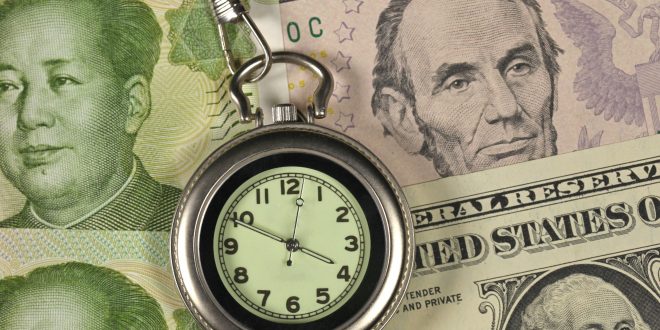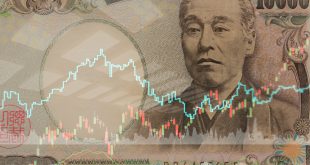The euro fell on Friday after economic data painted a mixed picture on growth and inflation in the euro-zone, adding to uncertainty about the percentage by which the European Central Bank is expected to raise interest rates next week.
Preliminary data showed gross domestic product in the euro zone grew by 0.1 percent in the first quarter, less than the 0.2 percent forecast in a Reuters poll.
The two largest economies in the eurozone, Germany and France, either stagnated or barely grew, while the Spanish and Italian economies grew more than expected.
The euro fell 0.4 percent to $1.0985, but remained near a one-year high, supported by expectations that the European Central Bank will continue to raise interest rates.
The euro briefly rose against the yen to its highest level since December 2014 at 149.50. It was last up 1.2 percent at 149.35 after the Bank of Japan kept its monetary easing policy unchanged.
The yen fell 1.55 percent to 136.11 against the dollar, its lowest since March 10.
The dollar rose overall, supported by data pointing to persistent inflation in the world’s largest economy, which boosted expectations of a 25 basis point interest rate hike at a US central bank meeting next week.
The dollar index rose 0.59 percent to 102.02 points, its highest level in one week and up from its lowest level in nearly two weeks, which it reached on Wednesday.
Data released on Thursday showed that while US economic growth slowed more than expected in the first quarter of the year, consumer spending accelerated, coupled with a rise in inflation.
Wall Street
On Friday, U.S. market indices rose as positive earnings reports from Exxon and Intel helped to allay concerns over Amazon’s slowdown warning and economic data confirmed predictions that the Federal Reserve will raise interest rates next week.
The oil major announced a record first-quarter profit on growing oil and gas output, helping to raise the S&P energy index by 1.5%. Exxon Mobil Corp (NYSE:XOM) shares ended the day up 1.3% after reaching an all-time high.
After announcing that gross margins will increase in the second half, chipmaker Intel Corp saw a 4% increase.
Despite better-than-expected quarterly results, Amazon.com Inc fell 4% in its biggest one-day loss since early February, signalling that its cloud computing business growth would slow further. It weighed on the consumer discretionary index, which finished down 0.04%.
After the market closed, First Republic Bank fell 49% to $1.77 on reports that the regional lender was headed for receivership. This followed the bank’s 43% drop during the normal trading session.
The benchmark S&P 500, on the other hand, gained for the week as well as the day and achieved its second straight monthly gain. It benefited from higher-than-expected results from megacap businesses such as Alphabet Inc, Microsoft Corp, and Meta Platforms Inc.
The Dow Jones Industrial Average rose 272 points, or 0.8%, to 34,098.16, the S&P 500 gained 34.13 points, or 0.83%, to 4,169.48 and the Nasdaq Composite added 84.35 points, or 0.69%, to 12,226.58.
For the month the S&P rose 1.5% while the Dow added 2.5% and the Nasdaq was barely higher. For the week the S&P rose 0.9% in line with the Dow’s weekly gain and the Nasdaq rose 1.3%.
Among the S&P 500’s 11 industry sectors the biggest gainer was energy while the biggest decliner was Utilities, which fell 0.2%.
The economically sensitive Dow Transportation index closed up 1.6% for the day but lost 2.7% for the week.
Analysts now expect first-quarter earnings for S&P 500 companies to fall 1.9% from a year ago compared with a 5.1% fall expected at the start of April, according to Refinitiv data.
Europe
European stocks rose by the end of trading on Friday, after corporate earnings and higher oil stocks helped the European Stoxx 600 index to overcome gloomy euro zone data and decline in banking stocks.
The pan-European STOXX 600 rose 0.6%, up 1.9% this month, boosted by corporate earnings after the March turmoil triggered by the collapse of two US banks and a government-sponsored bailout of Credit Suisse.
The real estate and healthcare sectors rose, 5.2 percent and 4.7 percent, respectively, outperforming major European sectors during the month. Technology and mining stocks posted the biggest monthly losses, down 4.7 percent and 5.6 percent, respectively.
Oil and gas stocks led the gains by the end of Friday and rose about 2 percent with the rise in crude oil prices, compensating for the drop in banking stocks, which fell 1.4 percent.
British bank NatWest fell 3.7 percent after announcing a drop in deposits of about 20 billion pounds in the first quarter. While the FTSE rose 3 percent in April, outperforming all major European indices.
Electrolux jumped 15.5 percent after the Swedish home appliance maker reported first-quarter sales.
Mercedes-Benz Group rose 0.7 percent, while German chemical maker Covestro rose 8.5 percent.
Asia
Japan’s Nikkei rose to an eight-month high on Friday after the Bank of Japan kept its ultra-loose monetary policy unchanged, boosting the index further after a series of strong corporate results boosted it.
The Nikkei index rose to 28,879.24 points for the first time since August 19, and closed near this level at 28,856.44 points, up 1.4 percent.
The broader Topix index closed up 1.23 percent to 2,057.48 points, its strongest level since March 9.
The yen fell 0.83 percent to just over 135 against the dollar, which supported shares of Japanese exporters, especially automakers.
Despite this, banking stocks were a victim of the BoJ’s decision, as they turned from gains of 2.64 percent in the morning to losses of 2.41 percent as low interest rates will continue to crush lending profits for the foreseeable future.
As was widely expected, the Bank of Japan kept its target level for short-term interest rates at -0.1% and for the 10-year yield near zero, and pledged to continue stimulus “patiently”.
He announced a “broad” review of his monetary policy, which could last a year and a half, which indicates a lack of haste in changing policies.
The banking index recorded the worst performance among the 33 sub-indices on the Tokyo Stock Exchange, but its losses fell significantly to only 0.28 percent at the close.
Transport equipment stocks rose 2.19 percent.
The losers on the Nikkei index were outnumbered by gainers, with 205 of 225 rising against a decline of 20.
Gold
Gold fell on Friday after rising inflation in the United States in March supported the dollar and boosted bets on a rate hike next week, but banking sector concerns kept bullion on a slight monthly rise.
And by 1350 GMT, gold in instant transactions fell 0.3% to $ 1982.65 an ounce, but it remained up 0.8% for the month. US gold futures fell 0.4 percent to $1,991.30.
The US core consumer spending measure, the Federal Reserve’s preferred measure of inflation, rose 0.3% in March, the same as in February, in line with expectations, with dealers raising bets on an interest rate hike next week.
And raising interest rates weakens the attractiveness of gold bullion.
The dollar maintained its gains after the inflation data, but headed towards a monthly decline. A weaker dollar makes bullion cheaper for overseas buyers.
Gold rose to the highest level in a year when the price of an ounce reached $ 2048.71 in mid-April, as the banking crisis spread.
Also being watched are developments surrounding the US debt ceiling.
As for other precious metals, silver fell 0.6% to $24.80 an ounce, platinum fell 0.9% to $1067.85, and palladium rose 1.1% to $1511.32, all heading towards a second monthly increase.
Oil
Oil prices rose more than 2 percent on Friday after US data showed a decline in crude oil production and at the same time an increase in demand for fuel.
Brent crude futures for June delivery rose $1.17, or 1.5 percent, to settle at $79.54 a barrel. These contracts expire on Friday. The most traded contract for the month of July jumped 2.7 percent to $80.33 upon settlement.
US West Texas Intermediate crude rose $2.02, or 2.7%, to $76.78 at settlement.
Although the two crude oil recorded daily gains, they fell for the second week in a row, and Brent crude recorded a decline for the fourth month amid the impact of disappointing US economic data and uncertainty about interest rates on demand expectations.
According to the Energy Information Administration, US crude production fell in February to 12.5 million barrels per day, the lowest level since December. Fuel demand rose to nearly 20 million barrels per day, the highest level since November.
Crude prices have fallen over the past weeks and months in light of concerns that interest rate moves may cut demand.
Brent crude fell by about 3 percent this week, after dropping about 5 percent last week, while West Texas Intermediate crude fell by about 1 percent this week, after dropping about 6 percent last week.
For the month of April as a whole, Brent crude fell less than 1%, while WTI rose nearly 1%, its first monthly increase in six months.
 Noor Trends News, Technical Analysis, Educational Tools and Recommendations
Noor Trends News, Technical Analysis, Educational Tools and Recommendations





